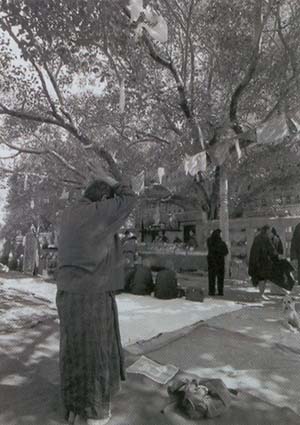It’s my Tibetan friend on the phone. “Hey, Papa Bush. Can you go to India?” He sometimes calls me “Papa Bush” or “Mr. President” because cab drivers, trick-or-treaters, and Tibetan monks alike seem to think I resemble the court-appointed leader of the Free World.
“Why? Do they need a little preemptive diplomacy?”
He tells me that Bodh Gaya—the site of the Buddha’s enlightenment—has been designated as a World Heritage Site by UNESCO (the United Nations Educational, Scientific and Cultural Organization), which selects sites of outstanding cultural value and ensures their protection through various kinds of aid, planning, and technical assistance. The Indian government’s Ministry of Tourism and Culture is hosting an International Buddhist conference in New Delhi, with the Dalai Lama and the president of India as featured guests. Rimpoche wants me to hop on a plane and check it out—right away.
Four days and a $95 emergency visa later, I am seated aboard an Air India jumbo jet on the fourteen-hour flight to Delhi. As a practicing Buddhist, I had long felt compelled to visit India. As a former plumber, I had hoped to avoid the shortcomings of third-world septic systems. However, upon my arrival I am promptly installed in a five-star hotel in New Delhi, reclining on a plush bed, TV remote in hand. In between CNN, a Yul Brynner cowboy movie, and Hindi soaps, I catch a glimpse of some guys doing a fire puja (a purification ritual), a shirtless fellow sitting in full lotus addressing a crowd of thousands, and rapt devotees pouring milk over a lingam (the phallic holy symbol of Shiva seen throughout India). As far as I can discern, there is no 900 number.
In the morning, I arrive at the First International Conclave on Buddhism and Spiritual Tourism, in the Plenary Hall of Vigyan Bhawan, a conference center complete with translation headsets at every seat. My fellow guests include monks and nuns representing most Asian Buddhist countries, and I wish I had a bhikkhu field guide to help identify all the colorful robes.
The President of India, Dr. A. P. J. Abdul Kalam, begins the proceedings with the announcement that his government is planning to reestablish the famous Buddhist university at Nalanda, the millennia-old site where many of the essential philosophical foundations of Buddhism were laid. H. H. the Dalai Lama delivers the keynote address, in which he stresses that Buddhist sites are “symbols of peace, compassion, and understanding that all religions could harness. These qualities represent the potential for the betterment of humanity and the reduction of conflicts.”
The Minister of Tourism and Culture, Sri Jagmohan, addresses the oxymoronic concept of “spiritual tourism.” His ministry has undertaken a program to make India’s sacred sites more welcoming to visitors whose main interest is in a contemplative experience. The Ministry has already implemented improvements at the caves of Ajanta, which house an extraordinary collection of Buddhist carvings and frescoes. They have moved the shops, banned vehicular traffic from the park, and reforested the area. Based on the success of Ajanta, he tells us, the ministry is creating a plan for Bodh Gaya, as well as the seven other principal Buddhist sites in India. The goal is to develop a circuit of improved transportation and facilities that will link the eight principal Buddhist sites and provide them with modern amenities.
Following the conference, I fly to Bodh Gaya for the UNESCO dedication ceremony. As we approach from the air, I contemplate the Buddha making his way from his palace to this site by foot twenty-five hundred years ago, and on the bus ride from the airport, it is apparent that little has changed since he stopped here. The edges of the sunken fields are flanked by low mud-and-brick huts covered with thatched roofs. Children wash cattle or herd them along the narrow paths that separate the fields.
At the site of Buddha’s enlightenment, Sri Jagmohan repeats his ministry’s commitment to the project and his contention that sacred Buddhist sites are the “property of all humanity.” I slip away from the VIPs. A locked fence has been erected around the Bodhi tree, preventing my approach, and the bark has been painted with a chemical to protect it from insects. But as luck would have it, the site’s caretakers are opening the gate for a group of Japanese nuns, and I am able to slip through. I circle the tree, kneel, and touch my forehead to the ground. Do I feel anything at that moment? Yes, I do: grateful. Grateful for the hope of “peace, compassion, and understanding” that began here—and of which I’m reminded every time a taxi driver swivels in his seat and asks, “Did anyone ever tell you, you look like . . . ?”
Thank you for subscribing to Tricycle! As a nonprofit, we depend on readers like you to keep Buddhist teachings and practices widely available.
